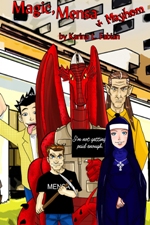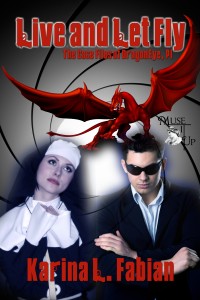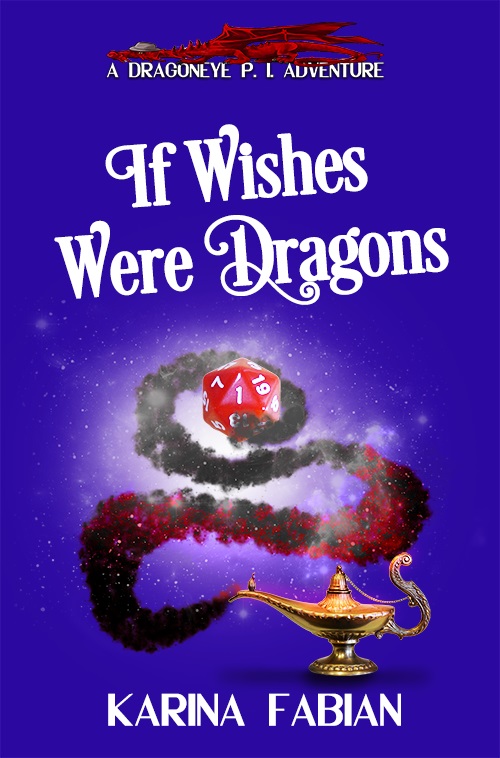 I’m excited to blog today about one of my dear characters, Sister Grace, for two reasons: First, her second book came out this month—Live and Let Fly. Second, her story, Siren Spell, comes out today from Flying Island Press.
I’m excited to blog today about one of my dear characters, Sister Grace, for two reasons: First, her second book came out this month—Live and Let Fly. Second, her story, Siren Spell, comes out today from Flying Island Press.
Sister Grace is not your typical nun. First of all, she’s not from our world. She was born in Ireland, but in the Faerie dimension, where magic, elves, demigods and all manner of unusual creatures are a fact of life. Secondly, she’s not fully human—but I’ll let you read about that in Flying Island. Suffice to say, it gave her some very powerful magical ability, which for the safety of herself and everyone, were consecrated to God when she was very young, Currently, Sister Grace is partnered with a dragon, Vern, and they run a private investigations agency here in our world. Most of the time they handle mundane (and Mundane) cases like finding lost animals or assisting the police when magic might be in play. Every so often, they have to take on major supernatural baddies to save our world and Faerie.
Grace is the perfect complement to a snarky, cynical and sometimes selfish dragon. She’s got the spunk—and the grace—to keep him in line and following God’s direction more willingly than he usually does. She’s also helped him enjoy his current situation. Vern is good for her, too—she feels protected and secure with him, and he makes her laugh, which she hadn’t done for a long time before they met. He also gave her the confidence to use her magic again after having faced some difficult temptations at the hands of some demons. The two love each other dearly—which makes things a little awkward when Vern turns human for the case in Live and Let Fly.
That’s what I love about Grace, though. She’s spiritual and utterly devoted to God, but she’s nonetheless human. She’s been known to lose her temper, grab people by the ear, even get into magical spats with other beings. She lets Vern get away with stuff now and then. (Check out Vern’s “Apologia on Extortion,” http:// flowersonthefence.blogspot.com.) But she’s also ready to sacrifice herself for others and always ready to follow God’s call. And her reaction to seeing her very best friend as a gorgeous guy? “Mary loved her sweet Joseph, and there have been plenty of married but celibate saints. I’ll be fine. But, just don’t touch me.”
Spirit, spunk, and a big dose of practicality. That’s Sister Grace.

About Live and Let Fly:
The magic is Faerie. The technology, Mundane. When they meet, the survival of the world rests in one dragon’s…er…claws. See Vern as you’ve never seen him before!
For a dragon detective with a magic-slinging nun as a partner, saving the worlds gets routine. So, when the US government hires Vern and Sister Grace to recover stolen secrets for creating a new Interdimensional Gap– secrets the US would like to keep, thank you—Vern sees a chance to play Dragon-Oh-Seven.
No human spy, however, ever went up against a Norse goddess determined to use those secrets to rescue her husband. Sigyn will move heaven and earth to get Loki—and use the best and worst of our world against anyone who tries to stop her.
It’s super-spy spoofing at its best with exotic locations (Idaho–exotic? Well, it is to them!), maniacal middle-managers, secret agent men, teen rock stars in trouble, man-eating animatronics, evil overlords and more!
Here’s an Excerpt with Vern and Grace talking the details of a case:
“Sure it was 2:30, exactly?”
Grace pulled off her shoes and massaged her feet. Then she wiggled her toes. She’s never cared for shoes. “They didn’t say exactly. Why?”
“Something about that time…”
Grace waited patiently while I mulled it over, then wracked my brains. Once upon a time, everything I learned I remembered; now “Wisdom of the Ages” is just a tag line on my Yellow Pages ad. I had my excellent memory back, but only of more recent events, and not always with perfect recall. There was something about the Gap and 2:30. Two-thirty. Two hundred thirty. Two-Three-Oh…
I felt more than heard Grace begin a prayer. She did that sometimes, prayed that a particular bit of knowledge would come to me. In fact, in our first case, her novena caused me to translate a popular song that turned out to be an ancient summoning rite—just in time, too.
I let it go. If there was something about the time we needed to know, God would help me remember. I settled myself down, arms tucked under my chest, and said my own dragon-style prayers until I saw Grace cross herself. “Hungry?”
“Ach, no. I’ve been filled with snacks.”
“Sure, nuns get pastries, but who feeds the dragon? After all, by now they know I prefer lunch meat over lovely maidens.”
She chuckled. “Well, someone hit a doe on the Gap road. Randy asked me to see if you were interested.”
“Best tip I’ve had all day. So how was the wedding?”
“Beautiful. Very simple, very heartfelt. A pleasure to sing at.”
I couldn’t help but grin at Grace’s starry gaze. Who said nuns can’t be romantics, too?
Then her expression changed. “Vern, do ye not think it’s time to apologize to Kitty?”
“Apologize?” I resisted the urge to ask, “What for,” since she’d come up with a list as long as my tail. “If I apologize to McGrue, she’ll only take that as evidence that she’s won somehow. That woman is as bad as—”
“—a dragon?”
There were times I’d rather face McGrue’s accusative stares than Grace’s guileless looks. Couldn’t she at least arch an eyebrow or something?
“I’m going to see what I can pick up at the Colt’s Hoof,” I growled on my way out.
Purchase on Amazon: http://tinyurl.com/amazonllf
Purchase from Publisher: http://tinyurl.com/LiveAndLetFly







